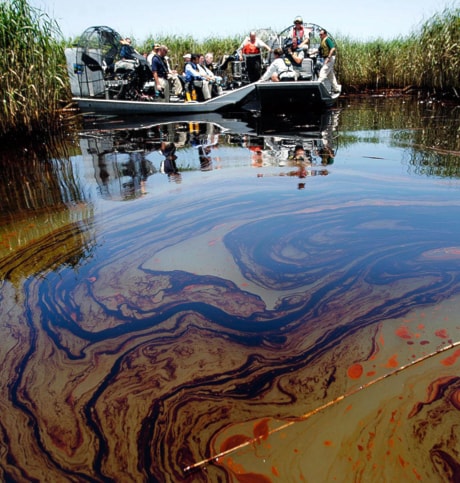NEW ORLEANS — BP conceded Thursday that more oil than it estimated is gushing into the Gulf of Mexico as heavy crude washed into Louisiana’s wetlands for the first time, feeding worries and uncertainty about the massive monthlong spill.
Mark Proegler, a spokesman for oil giant BP PLC, said a mile-long (1.6 kilometer-long) tube inserted into a leaking pipe over the weekend is now capturing 210,000 gallons (about 800,000 liters) a day — the total amount the company and the Coast Guard have estimated is gushing into the sea — but that some is still escaping. He would not say how much.
Several professors who have watched video of the leak have already said they believe the amount gushing out is much higher than the official estimates.
Proegler said the 210,000 gallons — 5,000 barrels — has always been just an estimate because there is no way of measuring how much is gushing from the seafloor.
A live video feed of the leak posted online Thursday at the insistence of U.S. Rep. Edward J. Markey, a Democrat from Massachusetts, shows what appears to be a large plume of oil and gas still spewing next to the tube that’s carrying some of it to the surface.
The well blew out after an explosion a month ago on the offshore drilling rig Deepwater Horizon that killed 11 people.
Brown ooze from the spill coated marsh grasses and hung in the shallow water of a wetland at Louisiana’s southeastern tip, the first heavy oil seen on shore so far. Gov. Bobby Jindal declared Wednesday it was just the outer edge of the real spill, much heavier than an oily sheen seen before.
“This is the heavy oil that everyone’s been fearing that is here now,” Jindal said during a boat tour. The wetlands at the mouth of the Mississippi are home to rare birds, mammals and a wide variety of marine life.
BP, which was leasing the rig when it exploded, was marshaling equipment and conducting tests Thursday ahead of a new effort to choke off the oil’s flow. Crews hoped that by Sunday they can start a procedure known as a “top kill,” which involves pumping heavy mud into the crippled equipment on top of the well, then permanently sealing it with cement.
The procedure has been used before to halt gushing oil above ground, but like other methods BP is exploring it has never been used 5,000 feet (1,524 meters) below the sea. That’s why scientists and engineers have spent much of the last week preparing for the complex operation and taking a series of measurements to make sure that the mission doesn’t backfire.
“The philosophy from the beginning is not to take any action which could make the situation worse, and those are the final steps we’re doing,” said Doug Suttles, BP’s chief operating officer.
BP is already sucking up oil through a mile-long tube it managed to insert into the leaking pipe over the weekend.
The National Oceanic and Atmospheric Administration said Wednesday that a small portion of the slick had entered the so-called loop current, a stream of faster moving water that circulates around the Gulf before bending around Florida and up the Atlantic coast. Its arrival may portend a wider environmental catastrophe affecting the Florida Keys and tourist-dotted beaches along that state’s east coast.
Even farther south, U.S. officials were talking to Cuba about how to respond to the spill should it reach the island’s northern coast, a U.S. State Department spokesman said.
Florida’s state meteorologist said it will be at least another seven days before the oil reaches waters west of the Keys, and state officials sought to reassure visitors that its beaches are still clean and safe.
Tar balls found earlier in the Florida Keys were not from the spill, the Coast Guard said Wednesday. Still, at least 6 million gallons (22.7 million liters) have already poured into the Gulf off Louisiana since the rig explosion that killed 11 workers and led to the spill, the worst U.S. environmental disaster in decades. The Exxon Valdez tanker spilled 11 million gallons (41.6 million liters) in Alaska in 1989.
Rep. Edward J. Markey, D-Mass., said in a news release that BP complied with his request that a live feed of the oil spill be made publicly available on the Web. Markey said it would start Wednesday night on his website.
U.S. Secretary of the Interior Ken Salazar said the government has access to that live video and scientists will be using it along with satellite imagery to check estimates from early on in the disaster that about 210,000 gallons (nearly 800,000 liters) a day was spewing into the ocean.
“The government will be making its own, independent verification of what those total numbers are,” Salazar said on the CBS “Early Show” Thursday.
Greenpeace activists scaled BP’s London headquarters Thursday to hang a flag accusing the oil company of polluting the environment. The group said the action was prompted by the Gulf of Mexico oil spill as well as a controversial project in Canada.
BP spokesman Robert Wine called the action “a very calm and genteel protest,” and said no employees had been prevented from getting to work.
